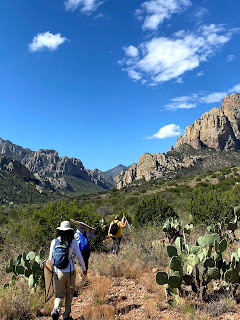Today was the first "official" day of our expedition! The ride from Tucson to the Chiricahua Mountains was absolutely amazing. The landscape was incredibly diverse; from the flat desert scattered with cacti, to the pecan orchards that seemed to go on for miles, the steep, rocky outcrops, and the various mountain ranges following us to the endless horizon.
When we arrived at Cave Creek Ranch, we were greeted by many birds, two javalinas, and whitetail deer.
Before going out in the field, we had enough time to get a short hike in. Another Earth-Watcher and I trekked up the nearby cliffside. About halfway through our hike, we stopped in an area that was clear and open so that we could take in the landscape surrounding us. We gazed up at the overlooking rock slopes in awe of their size and magnitude. It was then that we happened upon the reasoning for the name Cave Creek Ranch. Running off the cliffside was a small waterfall, falling below into the steep valley below. The water could be seen to have originated in one of the many visible caves and crevices within the rock.

Once in the field, we learned how the scientific method is used in the caterpillar studies and the steps that are taken before data collection occurs. First, we had to define a plot, determine where the plot would be, and then lay rope down to identify it. We then had to set up the drone pads around the center tree, so that there was a one-meter scale to reference the size of the trees and bushes within the plot to. Then we learned how to collect the data! We counted the number of leaves on each tree and bush in each of the quadrants, and then began collecting the caterpillars. We did so using beat sticks and a canvas. The caterpillars would fall onto the canvas once the branch they were on was struck with the stick. They were then transferred to cups, labeled, and given food from their host plant.


In the afternoon, we were shown the ropes in the lab/classroom. My task was to take photographs of some of the caterpillars. We needed to get a lateral photo (from the side), a dorsal photo (from above), and a headshot (self-explanatory). This proved to be much more difficult than it sounded. The caterpillars that I had would not stop moving which made taking a (highly magnified) focused photo ALMOST impossible.











Comments
Post a Comment